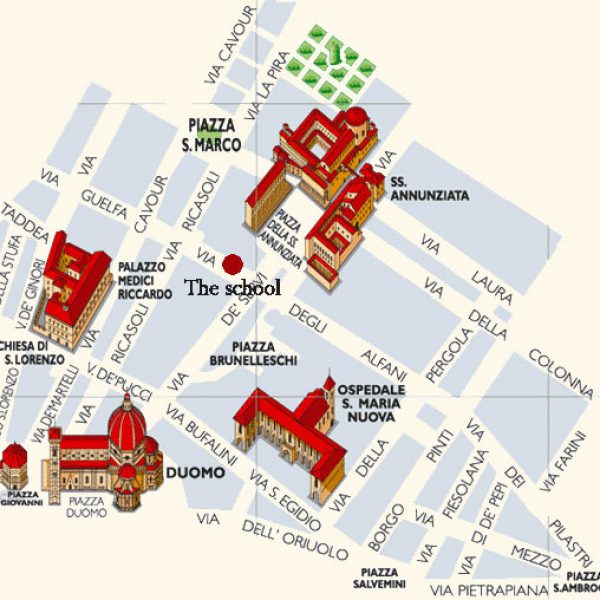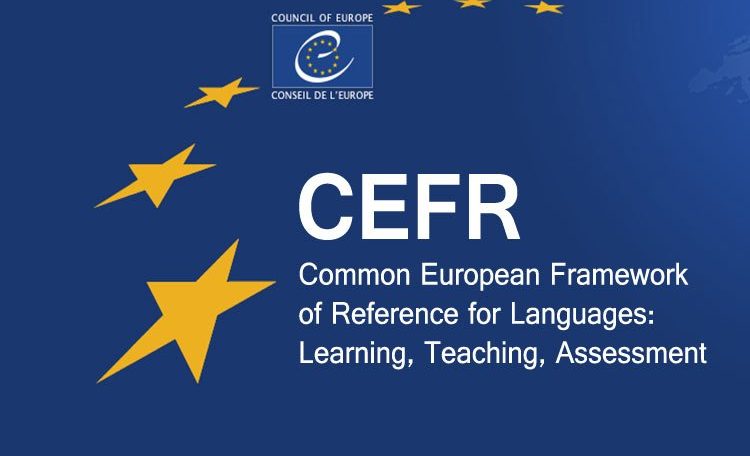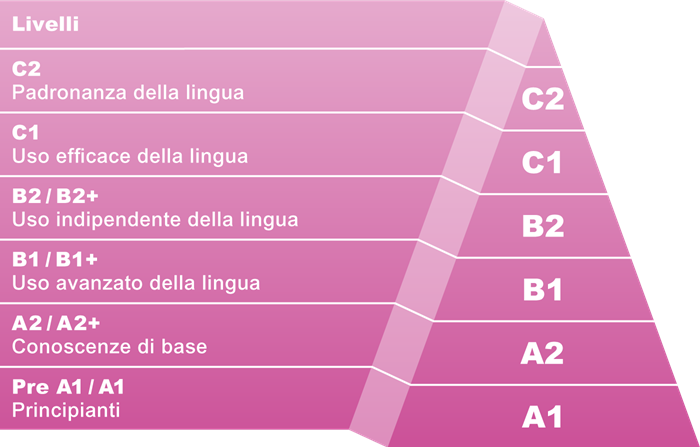Tel: (+39) 055 / 29 46 80 | Email: info@galilei.it
European levels & results
- Home
- |
- European levels & results

MINISTERO DELL’ISTRUZIONE,
DELL’UNIVERSITÀ E DELLA RICERCA
ITALIAN COURSES
COOKING, ART & CULTURE
TRANSLATIONS
LAST MINUTE
ENROLLMENT
REFERENCES
ITALIAN LANGUAGE TEST
Among Italian language schools for foreigners, the Galilei Institute is unique in its exclusive specializing in one-to-one, personalized, full immersion courses specifically designed for professionals and students. Established in 1985, the Galilei Institute attained the highest prestige among language schools in Italy by providing its services to the leading companies of the world. Please take a moment to review our list of clients.
Location of the school

european language levels & results
HOW MUCH TIME SHOULD YOU PLAN TO STUDY ITALIAN?
 Did you ask yourself how much time it does take to get as a beginner to an intermediate level of Italian (=B1 of the European language levels)? More and more often the level of language is indicated by the unified European standard indications (A1, A2, B1, B2, C1, C2), as simple indications like “intermediate” or “good knowledge” are very relative and depend mostly on an individual scale. This is why in Europe the requirements for language levels to enter certain jobs or universities are indicated by the European levels; following two examples:
Did you ask yourself how much time it does take to get as a beginner to an intermediate level of Italian (=B1 of the European language levels)? More and more often the level of language is indicated by the unified European standard indications (A1, A2, B1, B2, C1, C2), as simple indications like “intermediate” or “good knowledge” are very relative and depend mostly on an individual scale. This is why in Europe the requirements for language levels to enter certain jobs or universities are indicated by the European levels; following two examples:
- Level B1: minimum level of language knowledge requested in order to be able to access university courses or other professional courses
- Level C2:requested in order to access to exams for teaching the Italian language abroad
Below you can find a table with the explanation of what the abbreviations of the European language levels do mean as well as a general indication for how much time you should plan to reach a certain level, starting as a beginner and studying the language on a one-to-one bases, in a small group or a regular size group course. In order to know more about the reasons of these big differences between studying with a private teacher, with a smaller or bigger group of students, read the page of “considerations”.
Please note that the times indicated to reach a certain level are relative and not absolute. Also, for the upper levels they vary more. On the upper levels of European language levels, it is very important that the student applies the studied structures and has the opportunity of practicing the language.
EUROPEAN LANGUAGE LEVELS AND TYPES OF COURSES
 Regular size group courses usually follow a standard program suitable for a typical average student. This means that all the students of the group finish the course with a certain level of theoretical grammar knowledge. Still, the actual knowledge of the language depends on whether the student is able to put it into practice using the structures studied in speaking and writing. The actual knowledge therefore varies a lot with how much the student tries to put the studied structures into practise trying to speak the Italian language also outside class.
Regular size group courses usually follow a standard program suitable for a typical average student. This means that all the students of the group finish the course with a certain level of theoretical grammar knowledge. Still, the actual knowledge of the language depends on whether the student is able to put it into practice using the structures studied in speaking and writing. The actual knowledge therefore varies a lot with how much the student tries to put the studied structures into practise trying to speak the Italian language also outside class.
The one-to-one courses at the Institute Galilei , Italian school in Florence, follow a personal program tailored to the student’s linguistic needs and characteristics (see also “teaching method”). The program of grammar goes ahead according to the student’s daily results to be sure that the learnt structures are well understood and to prevent that the student gets overwhelmed and confused by going ahead too fast with the program. This is why the times involved to reach a certain level can vary a lot in a one-to-one course and is determined also by the student’s age, motivation, general understanding of languages as well as ability for learning languages.
Our small group courses ( max4 participants) follow a “general” program which is adapted to the needs of all the participants but goes ahead according to their actual results. Therefore, they are a perfect middle way between a regular size group course and a personalized one-to-one course. Also, these courses assure a high degree of active participation in class.
These time indications refer to the European language levels and are are calculated for language courses taken in the country where the language is spoken, starting from a beginner’s level. The courses are of 4 hours per day, from Monday through Friday. Taking a course of more lessons per day accelerates the learning process further (full immersion).
| European levels | Description of the language level* | One-to-one course | Small group coursw | Regular size group coursw |
| A1 – basic user-breakthrough | Can understand and use familiar everyday expressions and very basic phrases aimed at the satisfaction of needs of a concrete type. Can introduce him/herself and others and can ask and answer questions about personal details such as where he/she lives, people he/she knows and things he/she has. Can interact in a simple way provided the other person talks slowly and clearly and is prepared to help. | 1-2 weeks | 2-3 weeks | 1 month |
| A2 – basic user – waystage | Can understand sentences and frequently used expressions related to areas of most immediate relevance (e.g. very basic personal and family information, shopping, local geography, employment). Can communicate in simple and routine tasks requiring a simple and direct exchange of information on familiar and routine matters. Can describe in simple terms aspects of his/her background, immediate environment and matters in areas of immediate need. | 1-3 weeks | 3-4 weeks | 2 months |
| B1 – independent user – threshold | Can understand the main points of clear standard input on familiar matters regularly encountered in work, school, leisure, etc. Can deal with most situations likely to arise whilst travelling in an area where the language is spoken. Can produce simple connected text on topics which are familiar or of personal interest. Can describe experiences and events, dreams, hopes & ambitions and briefly give reasons and explanations for opinions and plans. | 4-5 weeks | 6-8 weeks | 3 months |
| B2 – independent user – vantage | Can understand the main ideas of complex text on both concrete and abstract topics, including technical discussions in his/her field of specialisation. Can interact with a degree of fluency and spontaneity that makes regular interaction with native speakers quite possible without strain for either party. Can produce clear, detailed text on a wide range of subjects and explain a viewpoint on a topical issue giving the advantages and disadvantages of various options. | 6-8 weeks | 8-12 weeks | 4 months |
| C1 – proficient user – effective operational proficiency | Can understand a wide range of demanding, longer texts, and recognise implicit meaning. Can express him/herself fluently and spontaneously without much obvious searching for expressions. Can use language flexibly and effectively for social, academic and professional purposes. Can produce clear, well-structured, detailed text on complex subjects, showing controlled use of organisational patterns, connectors and cohesive devices. | 12-16 weeks | 18-24 weeks | 6 or more months (depending on the student’s language abilities |
| C2 – proficient user – master | Can understand with ease virtually everything heard or read. Can summarise information from different spoken and written sources, reconstructing arguments and accounts in a coherent presentation. Can express him/herself spontaneously, very fluently and precisely, differentiating finer shades of meaning even in more complex situations. | about 4 months | 5 month | 8 or more months (depending on the student’s language abilities) |
* in order to have a complete description of each level in terms of the abilities of listening, reading, speaking and writing, please consult the official webpage of Europass at:
Official Europass Ability Levels
